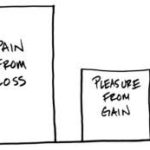Inflation Emotions
Kish Bank (www.mykish.com) has been hosting an Economic Outlook by economist Dr. Edmond Seifried for twenty-five years. I have attended about ten of them and always find them thought-provoking. As he is known, Dr. Ed gathers data on selected economic indicators that fall into categories that include rates like the Federal Fund Rate; Production & Business Activity like housing starts; and Price and Financial indicators like oil prices. Needless to say, his forecasts are data-driven.
He opened his 2023 outlook by distributing a seven-page document1 that lists the consumer price indices for more than 300 categories some as specific as flour and prepared flour mixes, eggs, ice cream, salad dressing, gasoline, appliances, televisions, and smartphones. Needless to say, it is a comprehensive list with the rate of inflation for all items being 7.1%.
He noted that some previous audiences had accused the government of lying when it reported inflation being that low. His purpose was to provide all of the detail that goes into that calculation.
I guess you would have to be cut off from all news reports to not know that inflation is a hot political issue. But I believe there is a psychological construct at play too. It is called loss aversion and I have written about it previously in this blog (https://www.tildensst.com/2017/10/17/whats-on-the-other-guys-mind-loss-aversion/). Loss aversion is based on a series of ingenious experiments conducted by psychologists Daniel Kahneman and Amos Tversky. Basically, loss aversion holds that the pain we suffer from a loss outweighs the pleasure of a gain.
Applying this principle, we would feel the pain more intensely at the grocery store when we pay almost 50% more for a dozen eggs, 18% more for a holiday turkey, or 13% more for our breakfast cereal. The pleasure we derive when we buy a smartphone at 23% less or replace a TV at a 17% reduction is far less than the pain we feel when we shop for groceries.
I don’t know if this has been part of the experiments conducted by Kahneman and Tversky, but I believe there is a frequency issue at play too. The pain we feel at the market is triggered in our household weekly while we buy smartphones every three years or so and have no immediate plans to replace a TV. And while the price of gasoline has dropped precipitously, we did feel the pain every time we filled up or saw the prices jump up on almost a daily basis as we drove by convenience stores or gas stations.
One of the lessons from Kahneman and Tversky is that emotions, not just rational thinking based on data, play a large role in our perceptions. By the way, I just looked at our home heating bill. Ouch!
1 To obtain the table on detailed CPI data, go to Bureau of Labor Statistics (BLS), click on economic data, find CPI, click pdf version, then go to Table B, pages 9-15
Recent Loss Aversion Dilemma
Shortly after posting this blog, my wife and I were confronted with a “loss aversion” dilemma while returning from a vacation in St. Petersburg Florida. While there, we visited the magnificent Dali Museum and purchased a poster of the intriguing Gala Contemplating the Mediterranean Sea for $30. If you are not familiar with this famous artwork, it shifts to a portrait of Abraham Lincoln when viewed from a distance. We had just the place for it in a corridor of our home.
The dilemma presented itself while waiting for our return flight when we heard an announcement that we would be billed $50 for any additional personal item we carried onto the plane. Thus the dilemma: (a) abandon the $30 poster; or (b) pay $50 to carry it on the plane?
Which would you choose (a) or (b)?
Let me know and I will compile the results and share them next time. I will also share what we did.


Hi Arnie,
Another great thought piece. Love the print, tough dilemma. So I had to google the artwork, and see that on Amazon you can get a framed version for about $75. Less than what you paid for the poster with the added cost of carrying it back home (let alone the inconvenience). Plus you still need to pay to get it framed. (Not sure if yours would be the same size, so not taking that into account.)
Even though I’m frugal I’d have sprung for the added cost as you have the memory of you and Becky getting it at the museum.
We need to get together in this new year.
Regards,
Michele (Kelly)
Hi Michele – Thanks for your comment, which is duly recorded. While we did feel the emotion of leaving the poster, we found a choice C solution which I will describe when we get together. Love the art even though I equate posters with college residence hall rooms – Arnie
Dali would have loved your dilemma.
I think Dali would love all dilemmas humans encounter. What would you do? Pay the fee or abandon the poster?
Call the museum have another shipped to my house. (A) Given the other poster to a stranger.
Brilliant! Best solution I have heard. Arnie